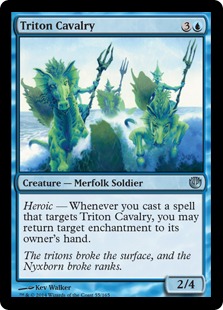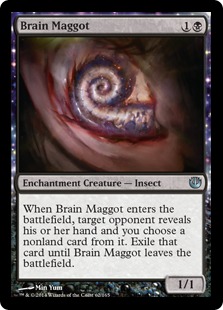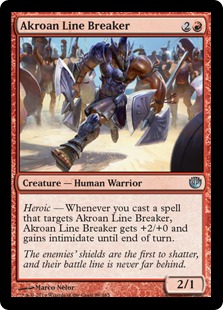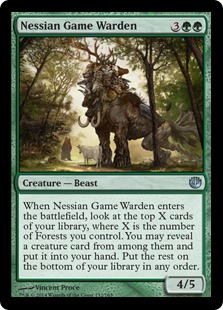This week I will look at five uncommons that are solid first picks in each color that you might have overlooked. As I said last week, the format has slowed down a lot, so the types of cards you want to first pick and build around have changed. Slow decks want engines and bombs, while aggressive decks want evasion and card advantage. Let’s get down to it.
Let’s start with a big one. I’ve made my love of seven drops in Journey draft known, but it bears repeating. Slow decks need to have bombs to take over the game. [casthaven]Quarry Colossus[/casthaven] fills that bill nicely. Remember in triple-Gatecrash how everyone thought [casthaven]Luminate Primordial[/casthaven] looked amazing but was too slow for that format? Well the colossus is basically the same card. Now that you have time to spend seven mana, a 5/6 beater that tucks their best creature into their library three to five cards deep is fantastic.
White especially needs an uncommon bomb to help finish games. [casthaven]Silent Artisan[/casthaven] can attack decently, and Supply-Line Cranes is quite good. But unless you luck into an [casthaven]Ornitharch[/casthaven] or a chase rare, white doesn’t have much beef at the top end. Taking a [casthaven]Quarry Colossus[/casthaven] to open your draft fills an important role and frees you to build a deck that can go late without being worried if you can find a finisher.
You want an engine for your durdly blue deck? Looking to repeatedly trigger constellation? How about messing with opposing auras at instant speed? Would you like a solid ground blocker to boot? Meet [casthaven]Triton Cavalry[/casthaven]. This little four drop packs a ton of value. The dream is cycling through two cantrip auras repeatedly, drawing cards and triggering your [casthaven]Grim Guardian[/casthaven]s or Thassa’s Devourers. But you can also use [casthaven]Retraction Helix[/casthaven] on the cavalry, bounce a creature and send an aura back to your hand that you can redeploy to build up your [casthaven]Wingsteed Rider[/casthaven].
And then there’s the fact that it lets you bounce any enchantment, not just your own. Get rid of a pesky bestow aura after blocks and eat the now-naked creature. As a 2/4 the cavalry can even do the eating in the right situation. [casthaven]Riptide Chimera[/casthaven] might be more powerful, but [casthaven]Triton Cavalry[/casthaven] offers such flexibility that you absolutely want this card in your blue deck. You can hit any aura, and you get to choose when it happens. Sign me up!
Maybe this one is obvious, but I’m not so sure. I’d rather have [casthaven]Thoughtseize[/casthaven], for any number of reasons, but [casthaven]Brain Maggot[/casthaven] offers a powerful “discard” effect as well. You have to be prepared to see your maggot destroyed by everything from [casthaven]Mortal Obstinacy[/casthaven] to [casthaven]Eye Gouge[/casthaven], but even if they get the card bacl you were able to plan your game around their hand and disrupt their plan for a few turns. Pair this with [casthaven]Disciple of Phenax[/casthaven] and you can play a real discard strategy. Slower formats hinge on card advantage, and [casthaven]Brain Maggot[/casthaven] offers a fragile two-for-one while depleting opposing resources.
Even though being an enchantment makes the maggot more vulnerable, it adds another level of power to the card. Black decks are hungry for enchantments to trigger constellation and full of resources to recur the maggot if it happens to die. Not only that, you can beef it up with [casthaven]Nyx Infusion[/casthaven] and hit for some real damage. This card is a winner and one I’m happy to take first.
Aggressive decks have gotten a lot weaker, but you can still build a good deck in that archetype. Two new aspects of the format now that Journey has joined the mix are holding aggro back—decks are less consistent due to three different packs in draft and defensive decks have many more effective blockers. For example, Nyx-Fleece Ram can block a two drop and survive a [casthaven]Battlewise Valor[/casthaven], where [casthaven]Returned Phalanx[/casthaven] can’t.
Here’s where [casthaven]Akroan Line Breaker[/casthaven] does great work. Good luck blocking this thing. You are much better off trying to kill it. Unless you have [casthaven]Guardians of Meletis[/casthaven] to hold off a five power intimidator, you won’t have good options to keep your lines unbroken. Unless you happen to have some red creatures around, of course.
Line Breaker has been criticized for needing to get the heroic trigger before blockers in order to take advantage of the evasion, but I think this is overblown. First off, you don’t want this thing to be blocked. Second, it isn’t getting an extra toughness boost from the heroic trigger, so you probably can’t save it from trading in combat anyway. Third and most importantly, red’s best heroic enablers are auras, not tricks. [casthaven]Dragon Mantle[/casthaven], [casthaven]Nyxborn Rollicker[/casthaven], [casthaven]Everflame Eidolon[/casthaven], and [casthaven]Fearsome Temper[/casthaven] play fantastically with [casthaven]Akroan Line Breaker[/casthaven], and they eliminate the drawback of needing to trigger heroic before combat.
It comes down to this. If you want to win quickly, you have to force through damage. [casthaven]Akroan Line Breaker[/casthaven] does that, and it works well with red’s other strong cards.
And here we have card advantage. A 4/5 body for five mana is already solid. [casthaven]Nessian Asp[/casthaven] is the obvious gold standard, but the game warden compares fairly well. Sure, it isn’t getting bigger than 4/5 on its own, but it most likely brings a friend to the table. That could even be a bestow creature, which can in turn beef up the game warden.
Most likely you’ll have three forests if you cast this on curve, and any self-respecting green deck is more than one third creatures. That means you will almost always draw a card off [casthaven]Nessian Game Warden[/casthaven], and you even get the choice of the best one if you hit multiples. It doesn’t enable graveyard shenanigans, but that doesn’t bother me. I am always wary of depleting too much of my deck by dumping chunks of cards into the graveyard. This is a real thing in limited, where four cards are tne percent of your deck. [casthaven]Satyr Wayfinder[/casthaven] and [casthaven]Commune with the Gods[/casthaven] do enough work to pitch cards into the yard. Game warden lets you play another drawing effect while still leaving cards in your library for later. I am a big fan.
So there you have it. Looking for some direction in your next Journey draft? Try one of these uncommons and see how it goes. Let me know what you think!
Carrie O’Hara is Editor-in-Chief of Hipsters of the Coast.






